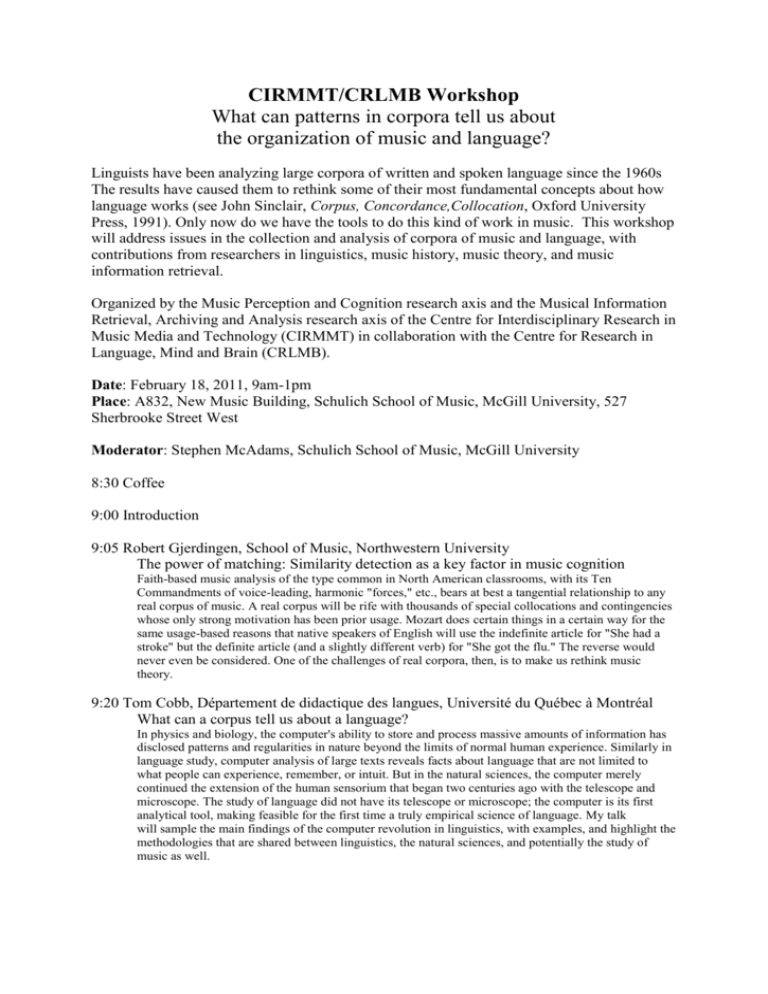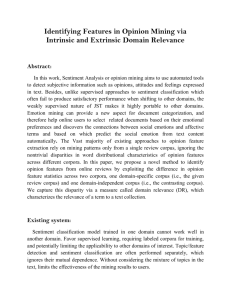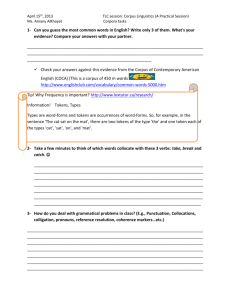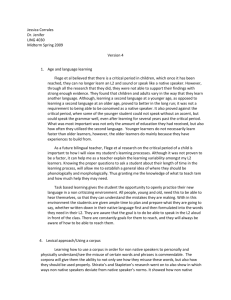CIRMMT/CRLMB Workshop
advertisement

CIRMMT/CRLMB Workshop What can patterns in corpora tell us about the organization of music and language? Linguists have been analyzing large corpora of written and spoken language since the 1960s The results have caused them to rethink some of their most fundamental concepts about how language works (see John Sinclair, Corpus, Concordance,Collocation, Oxford University Press, 1991). Only now do we have the tools to do this kind of work in music. This workshop will address issues in the collection and analysis of corpora of music and language, with contributions from researchers in linguistics, music history, music theory, and music information retrieval. Organized by the Music Perception and Cognition research axis and the Musical Information Retrieval, Archiving and Analysis research axis of the Centre for Interdisciplinary Research in Music Media and Technology (CIRMMT) in collaboration with the Centre for Research in Language, Mind and Brain (CRLMB). Date: February 18, 2011, 9am-1pm Place: A832, New Music Building, Schulich School of Music, McGill University, 527 Sherbrooke Street West Moderator: Stephen McAdams, Schulich School of Music, McGill University 8:30 Coffee 9:00 Introduction 9:05 Robert Gjerdingen, School of Music, Northwestern University The power of matching: Similarity detection as a key factor in music cognition Faith-based music analysis of the type common in North American classrooms, with its Ten Commandments of voice-leading, harmonic "forces," etc., bears at best a tangential relationship to any real corpus of music. A real corpus will be rife with thousands of special collocations and contingencies whose only strong motivation has been prior usage. Mozart does certain things in a certain way for the same usage-based reasons that native speakers of English will use the indefinite article for "She had a stroke" but the definite article (and a slightly different verb) for "She got the flu." The reverse would never even be considered. One of the challenges of real corpora, then, is to make us rethink music theory. 9:20 Tom Cobb, Département de didactique des langues, Université du Québec à Montréal What can a corpus tell us about a language? In physics and biology, the computer's ability to store and process massive amounts of information has disclosed patterns and regularities in nature beyond the limits of normal human experience. Similarly in language study, computer analysis of large texts reveals facts about language that are not limited to what people can experience, remember, or intuit. But in the natural sciences, the computer merely continued the extension of the human sensorium that began two centuries ago with the telescope and microscope. The study of language did not have its telescope or microscope; the computer is its first analytical tool, making feasible for the first time a truly empirical science of language. My talk will sample the main findings of the computer revolution in linguistics, with examples, and highlight the methodologies that are shared between linguistics, the natural sciences, and potentially the study of music as well. 9:35 Julie Cumming and Peter Schubert, Schulich School of Music, McGill University Patterns of imitation in Renaissance music How can we apply corpus, concordance, and collocation approaches to the study of Renaissance music? What kinds of musical units might correspond to words? Or to collocations? Renaissance treatises taught improvisation and composition by starting with dyad pairs: move from one interval to another, such as movement from third to fifth, with one voice moving by step. These dyad pairs could be considered analogous to words, and sequences of dyad pairs to collocations. Corpus study could allow us to identify the most common dyad pairs. Certain contrapuntal techniques constrain the sequence of dyad pairs; we would like to look at the stretto fuga patterns as a possible analogue to collocation. 9:50 Jonathan Wild, Ichiro Fujinaga and Ashley Burgoyne, Schulich School of Music, McGill University Some early results from the Billboard project We present an initial report on our FQRSC-supported research project, which builds a database of harmonic progressions transcribed from a random sampling of the Billboard "Hot 100" charts, from the late 1950s to the early 1990s. As the charts document musical trends at quite a fine-grained scale (i.e. week-to-week) it is possible to discern trends in harmonic idioms as they vary with the passing years, once a dense enough sampling has been achieved. Here we discuss some issues of harmonic encoding and some preliminary queries attempted on the database. 10:05 Ichiro Fujinaga, Ashley Burgoyne and Andrew Hankinson, Schulich School of Music, McGill University Creating ground-truth data for analyzing large corpora of music The experiences from creating ground-truth data for: SALAMI project (structural/formal analysis), Billboard project (harmonic analysis), and Liber Usualis project (square notation) will be presented. Issues to be raised include the amount of ground-truth data needed and the quality of ground-truth data. 10:20 Nicole Biamonte, Schulich School of Music, McGill University Strategies of metric consonance and dissonance in rock music I will identify some basic strategies for the long-range deployment of metric dissonance in rock music, with a focus on Anglophone classic rock and progressive rock (a genre in which metric play is a stylistic hallmark). In many instances, schemes of metric tension and resolution support analogous patterns in other domains such as pitch, texture, and timbre that are strongly isomorphic with the largescale tonal and motivic plans of establishment, departure, and return that underlie much commonpractice art music, as well as analogous patterns in literature such as rhetoric, drama, and narrative. 10:35 Trevor de Clerq and David Temperley, Eastman School of Music, University of Rochester Harmony and key in rock: A corpus study We report recent work on harmony and key in rock music. We took 200 songs from a list in Rolling Stone magazine and analyzed the harmony using Roman numerals. We examined aggregate statistics regarding the frequency of different chords and chord progressions; this yields a number of interesting findings regarding the harmonic language of rock. More recently we have been experimenting with various kinds of statistical key-finding algorithms, trained and tested on our corpus. 11-11:30 - Coffee break 11:30-1:00 - Structured discussion of the emerging issues 1:00-2:00 - Buffet lunch







